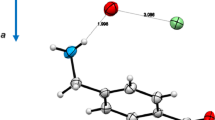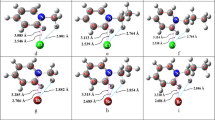Abstract
Density functional theory (DFT) B3LYP at 6-31G* level is employed to optimize the structures of the molecules bridged through n-vertex bis-substituted carborane (n=5, 6, 7) and combined with finite field (FF) formalism to calculate the second-order NLO properties. The results indicate that the structures of n-vertex bis-substituted carborane (n=5, 6, 7) are changed due to bridged donor and acceptor moieties. The distances between two C atoms are becoming longer. And the stability and dipole moment are influenced by changing substituted positions of C atoms. The isomers with the substituents connecting with C atoms of lower coordination number have better stability and larger values of polarizability. One-dimensional structure of the molecules bridged through n-vertex bis-substituted carborane (n=5, 6, 7) is in favor of intramolecular charge-transfer. Meanwhile, the isomer with a larger change of dipole moment has larger value of second-order NLO properties during the charge-transfer process.
Similar content being viewed by others
References
Ltiets L A. Vibrational spectroscopy of carboranes and parent boranes and its capabilities in carborane chemistry. Chem Rev, 1992, 92(2): 279–323
Zhang M Y, Zhou J W, Yu W Z. A theoretical study on the vibrational spectra of bis(C-p-carboranyl)(C2B10H11)2. J Mol Struct (Theochem), 1999, 458(3): 263–267
Zhang M Y, Zhao Y F. Ab initio study on the structural features of icosahedral carboranes containing heteroatoms. J Mol Struct (Theochem), 2001, 554(1): 105–110
Tian S X. Theoretical study of isoelectronic molecules: B6H10, 2-CB5H9, 2,3-C2B4H8, 2,3,4-C3B3H7, and 2,3,4,5-C4B2H6. J Phys Chem A, 2005, 109(29): 6580–6586
Pati R, Pineda A C, Pandey R, et al. Ab initio quantum chemical study of electron transfer in carboranes. Chem Phys Lett, 2005, 406(4–6): 483–488
Endo Y, Ohta K, Yoshimi T, et al. A new application of inorganic cluster, carboranes for medicinal drug design and molecular construction. Phosphorus Sulfur Silicon Rel Elements, 2004, 179(4–5): 799–802
Lesnikowski Z J. Boron clusters—A new entity for DNA-oligonucleotide modification. Europ J Org Chem, 2003, (23): 4489–4500
Franken A, Kilner C A, Kennedy J D. Polyhedral monocarbaborane chemistry. Carboxylic acid derivatives of the [closo-2-CB9H10]− anion. Chem Commun, 2004, (3): 328–329
Grimes R N. Boron clusters come of age. J Chem Educ, 2004, 81(5): 657–671
Tjarks W. The use of boron clusters in the rational design of boronated nucleosides for neutron capture therapy of cancer. J Organometallic Chem, 2000, 614–615: 37–47
Endo Y, Yamamoto K, Kagechika H. Utility of boron clusters for drug design. Relation between estrogen receptor binding affinity and hydrophobicity of phenols bearing various types of carboranyl groups. Bioorg Med Chem Lett, 2003, 13(22): 4089–4092
Grimes R N. Potential applications of the boron cluster compounds. Chem Rev, 1992, 92(2): 269–278
Allis D G, Spencer J T. Polyhedral-based nonlinear optical materials. Part 1. Theoretical investigation of some new high nonlinear optical response compounds involving carboranes and charged aromatic donors and acceptors. J Organometallic Chem, 2000, 614–615: 309–313
Allis D G, Spencer J T. Polyhedral-based nonlinear optical materials. 2.1 Theoretical investigation of some new high nonlinear optical response compounds involving polyhedral bridges with charged aromatic donors and acceptors. Inorg Chem, 2001, 40(4): 3373–3380
Salam A, Deleuze M S, Francoic J P. Ab initio and density functional theory calculation of the structure and vibrational properties of n-vertex closo-carboranes, n=5, 6 and 7. Chem Phys, 2001, 271(1): 17–30
Frisch M J, Trucks G W, Schlegel H B, et al. Gaussian 03, Revision C.02. Wallingford CT: Gaussian, Inc., 2004
Meyer F, Marder S R, Piere B M, et al. Electric field modulated nonlinear optical properties of donor-acceptor polyenes: Sum-over-states investigation of the relationship between molecular polarizabilities (alpha, beta, and gamma) and bond length alternation. J Am Chem Soc, 1994, 116(23): 10703–10714
Kanis D R, Ratner M A, Marks T J. Design and construction of molecular assembiles with large second-order optical nonlinearities. Quantum chemical aspects. Chem Rev, 1994, 94(1): 195–242
Author information
Authors and Affiliations
Corresponding author
Additional information
Supported by the Foundation of Jilin Provincial Excellent Youth (Grant No. 20050107) and Youth Science Foundation of Northeast Normal University (Grant No. 111494117)
About this article
Cite this article
Qiu, Y., Chen, H., Sun, S. et al. Structure and second-order NLO property of the molecules bridged through n-vertex bis-substituted carborane (n=5, 6, 7). CHINESE SCI BULL 52, 2326–2330 (2007). https://doi.org/10.1007/s11434-007-0328-4
Received:
Accepted:
Issue Date:
DOI: https://doi.org/10.1007/s11434-007-0328-4




